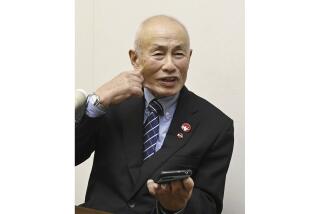U.S. Transplant Doctors Share Medicine Nobel
- Share via
Two American physicians who pioneered organ transplantation techniques that have helped save tens of thousands of patients were jointly awarded the Nobel Prize in medicine Monday.
The Nobel Assembly at the Karolinska Institute in Stockholm conferred the prestigious award on Dr. Joseph E. Murray, 71, of Boston’s Brigham and Women’s Hospital, and Dr. E. Donnall Thomas, 70, of the Fred Hutchinson Cancer Research Center in Seattle.
Murray headed the surgical team that performed the first successful human kidney transplant, on Dec. 23, 1954. Later, Murray discovered how the rejection of organs after transplantation could be controlled. Kidney transplants are now widely used to treat kidney failure.
Thomas performed the first human bone marrow transplant in Cooperstown, N.Y., in 1956. Later, he discovered how to diminish the potentially lethal “graft-versus-host” reaction that a bone marrow transplant can cause in the recipient. Bone marrow transplants are now widely used to treat otherwise fatal blood diseases. They are also used in combination with chemotherapy for leukemia and some tumors.
These discoveries “are crucial for those tens of thousands of severely ill patients who either can be cured or given a decent life when other treatment methods are without success,” the citation from the Nobel Assembly said.
At a hastily called press conference in San Francisco, where he is attending a surgical meeting, Murray used the occasion to decry the current shortage of organs for transplantation and to lash out at animal rights activists.
“None of this could have been done without animal experimentation,” he said. “It’s a tragedy and a waste of resources that scientists have to combat the antivivisectionists.”
Of his Nobel, Murray said: “It’s extremely gratifying. It means the work was worthwhile, I guess.”
Thomas, interviewed by wire services at his home in Bellevue, Wash., outside Seattle, struck a similar theme: “It’s an honor and a thrill for 40 years of work. . . . It’s been a long, hard process.
Kidney, heart, liver and bone marrow transplants are commonplace today. But decades ago, pioneers like Murray and Thomas had to overcome widespread scientific skepticism. The initial transplantation would often appear successful, but soon patients would suffer lethal infection, bleeding or organ rejection.
Murray’s first successful kidney transplant came after 15 failures. It was performed between two brothers who were genetically identical. The recipient, Ronald Herrick, lived seven years before dying of heart disease.
Still, Murray recalled, “we were struck with the moral problem of removing a healthy organ from a healthy person,” even though “one can live perfectly well on one kidney.”
Doctors consulted members of the clergy and even sought, and received, a special decree from the Massachusetts Supreme Court allowing the operation to go forward.
A string of advances soon followed. After surgery, the doctors used steroids, other powerful drugs and radiation to suppress the immune system, so that transplants would not be rejected. Although kidney dialysis technology was being developed concurrently, Murray’s team “felt that replacing the kidney would be a more permanent solution,” he said.
In 1959, Murray and his colleagues transplanted a kidney between brothers who were not genetically identical. In 1962, they performed the first successful human kidney transplant using a kidney from the cadaver of an unrelated donor. The recipient survived for more than a year.
After this advance, “the field was then open for transplantation of other organs such as liver, pancreas and heart,” the Nobel Assembly citation said.
Unlike a kidney transplant, a bone marrow transplant is more akin to a blood transfusion than an operation. Bone marrow cells are removed from the hip bone of the donor. A needle is placed in the bone and cells are drawn into syringes. The cells are processed and then infused into the recipient through a vein.
As Thomas and his colleagues discovered, these donated bone marrow cells were able to repopulate the recipient’s bone marrow and produce new blood cells.
“There are literally thousands of patients alive today because of Dr. Thomas’ initial efforts,” said Dr. Stephen Forman, a bone marrow transplant specialist at the City of Hope National Medical Center in Duarte.
The prize shared by Murray and Thomas is worth about $700,000. It is endowed by the will of Alfred B. Nobel, the inventor of dynamite, who died in 1896.
The two physicians did not collaborate on their award-winning work, but they both attended Harvard Medical School and began their medical careers at about the same time at the Brigham, the Harvard-affiliated hospital where Murray still works. He retired from active surgery four years ago.
Thomas “was a resident in medicine and I was a resident in surgery,” Murray said. “This was after World War II. We both started working in transplants together, but from two different angles. It’s marvelous to share (the prize) with him.”
Thomas joined the University of Washington faculty in 1963. He has worked at the Fred Hutchinson Cancer Center since it opened in 1975.
On a personal note, Murray said he continues to correspond with his longest-living kidney transplant recipient, Edith Helm. Helm, an identical twin who received a kidney from her sister in May, 1956, “went on to have a child and is now a grandmother.”
Beaming with pleasure in telling the story, Murray said: “The donor is also a grandmother. Together, they have a slew of grandchildren.”
Zonana reported from San Francisco.






